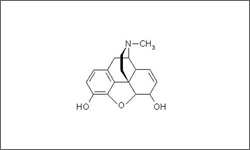Morphine

Morphine can be given as a tablet, liquid, suppository or injection. Dosage depends on the form of morphine administered. Morphine is available in several forms Astramorph® injection, Avinza® extended-release capsules, Duramorph® injection, Infumorph® solution, Kadian® sustained-release capsule, MS CONTIN® controlled-release tablets, MSIR® immediate-release tablets, capsules, or solution, Oramorph® sustained-release tablets, Roxanol® oral solutions and suppositories.1
- 1 Morphine. MedlinePlus. 2016. https://medlineplus.gov/druginfo/meds/a682133.html
Morphine is an opiate that binds primarily to the mu opioid receptor to relieve pain, which works by changing the way in which the brain and nervous system respond to pain.1
The 3D diagram above shows the molecular structure of Morphine.
- 1 Morphine. MedlinePlus. 2016. https://medlineplus.gov/druginfo/meds/a682133.html
A chief hazard of morphine therapy is respiratory depression. This may result in a potentially dangerous slowing of a patient's breathing rate. Morphine can be habit forming. Psychological and physiological withdrawal symptoms can occur if the patient becomes drug dependent. With prolonged use, tolerance may also become a problem, requiring higher dosages to achieve pain relief. Alcohol can intensify some of the mental and emotional side effects of morphine, such as drowsiness and changes in mood. Patients should avoid alcohol consumption while taking Morphine.1
- 1 Morphine. MedlinePlus. 2016. https://medlineplus.gov/druginfo/meds/a682133.html
